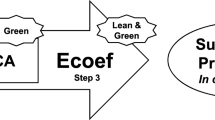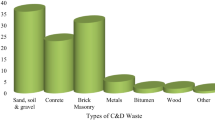Abstract
Lean principles provide improvement to the efficiency of construction by synchronizing the process of building and eliminating waste, which in turn can have a positive impact on the environment. This is generating a growing interest in linking the relationship between lean and low carbon. The authors compare the carbon emission in the truss construction process of a steel structured building in China optimized by lean principles with the original process. A partial life cycle assessment (LCA) framework is used to calculate the embodied carbon of materials, energy consumption of transportation from cradle to site, energy consumption of construction equipment and disposal of construction waste. This confirms through case study and measurement what had previously been proposed and adds the aspect of site efficiency into the current method for life cycle assessment of carbon emission. The results show that the lean process had an embodied carbon of 5532.1t CO2e delivering a reduction of 43t compared to the original process, demonstrating lean interventions can have a positive impact on the environment. This study establishes the link between the efficiency of the construction process and low carbon using empirical evidence demonstrating that contractors can use lean principles in their construction processes to improve efficiency and reduce carbon emissions as a result.
Similar content being viewed by others
References
IPCC, Climate change 2007 - the forth assessment report of the intergovernmental panel on climate change, IPCC. Geneva, Switzerland (2007)
Jiang, P., Keith Tovey, N.: Opportunities for low carbon sustainability in large commercial buildings in China. Energy Policy 37, 4949–4958 (2009)
Jiang, M.P., Tovey, K.: Overcoming barriers to implementation of carbon reduction strategies in large commercial buildings in China. Build. Environ. 45, 856–864 (2010)
Environmental Protection Agency (EPA), Potential for Reducing Greenhouse Gas Emissions in the Construction Sector, EPA (2009)
Yan, H., et al.: Greenhouse gas emissions in building construction: A case study of One Peking in Hong Kong. Build. Environ. 45, 949–955 (2010)
Monahan, J., Powell, J.C.: An embodied carbon and energy analysis of modern methods of construction in housing: A case study using a lifecycle assessment framework. Energy Build. 43, 179–188 (2011)
Chen, G.Q., et al.: Low-carbon building assessment and multi-scale inputoutput analysis. Commun. Nonlinear Sci. Numer. Simul. 16, 583–595 (2011)
Yu, D., Tan, H., Ruan, Y.: A future bamboo-structure residential building prototype in China: Life cycle assessment of energy use and carbon emission. Energy Build. 43, 2638–2646 (2011)
Blengini, G.A.: Life cycle of buildings, demolition and recycling potential: A case study in Turin, Italy. Build. Environ. 44, 319–330 (2009)
Gerilla, G.P., Teknomo, K., Hokao, K.: An environmental assessment of wood and steel reinforced concrete housing construction. Build. Environ. 42, 2778–2784 (2007)
Tae, S., Baek, C., Shin, S.: Life cycle CO2 evaluation on reinforced concrete structures with high-strength concrete. Environ Impact Assess. Rev. 31, 253–260 (2011)
Tae, S., et al.: The development of apartment house life cycle CO2 simple assessment system using standard apartment houses of South Korea. Renew. Sustain. Energy Rev. 15, 1454–1467 (2011)
Suzuki, M., Oka, T.: Estimation of life cycle energy consumption and CO2 emission of office buildings in Japan. Energy Build. 28, 33–41 (1998)
Koskela, L.J., Ballard, G., Howell, G., Tommelein, I.: The foundations of lean construction. In: Design and Construction: Building in Value, pp. 211–226. Butterworth Heinemann, Oxford (2002)
Howell, G.A.: What is lean construction. In: Proceedings IGLC-7. Berkeley (1999)
Horman, M.J., Riley, D.R.: Lean and green: Integrating sustainability and lean construction. In: Proceedings IGLC-15. Michigan (2007)
Bae, J.-W., Kim, Y.-W.: Sustainable value on construction project and application of lean construction. In: Proceedings IGLC-15, pp. 312–321. Michigan (2007)
Rosenbaum, S., Toledo, M, Gonzalez, V.: Green-lean approach for assessing environmental and production waste in construction. In: Proceedings IGLC-20. Toledo (2012)
Luo, Y., Riley, D.R., Horman, M.J.: Lean principles for prefabrication in green design-build (GDB) projects. In: Proceedings IGLC-13. Sydney (2005)
Huovila, P., Koskela, L.: Contribution of the principles of lean construction to meet the challenges of sustainable development. In: Proceedings IGLC-6. Guaruja (1998)
King, A., Lenox, M.: Lean and green: An empirical examination of the relationship between lean production and envionmental performance. Prod. Oper. Manag. 10, 244–256 (2001)
Ramesh, T., Prakash, R., Shukla, K.K.: Life cycle energy analysis of buildings: An overview. Energy Build. 42, 1592–1600 (2010)
Cooper, J.S., Fava, J.: Life cycle assessment practitioner survey: Summary of results. J. Ind. Ecol. (2006)
The National Institute of Standards and Technology (NIST): BEES online tutorial. http://ws680.nist.gov/Bees/Help.aspx(2011). Accessed 25 March 2013
Green Design Institute of Carnegie Mellon University: Theory and Method behind EIO-LCA. http://www.eiolca.net/Method/eiolca%20math.pdf(2013). Accessed 25 June 2013
Athena Sustainable Materials Institute: Athena Impact Estimator for Buildings V 4.2 Software and Database Overview. http://calculatelca.com/wp-content/uploads/2011/11/ImpactEstimatorSoftwareAndDatabaseOverview.pdf(2012). Accessed 10 March 2013
Japan Sustainable Building Consortium (JSBC): CASBEE for New Construction: Technical Manual. http://www.ibec.or.jp/CASBEE/english/download/CASBEE-NC_2010manual.pdf(2010). Accessed 10 March 2013
Environment Agency: Waste and Resources Assessment Tool for the Environment (WRATE). http://www.environment-agency.gov.uk/research/commercial/102922.aspx(2012). Accessed 10 March 2013
Ministry of Housing and Urban- Rural Development (MOHURD): Evaluation standard for green building (GB 50378-2006), MOHURD, China (2006)
U.S. Green Building Council: LEED v4 User Guide. http://www.usgbc.org/sites/default/files/LEED%20v4%20User%20Guide.pdf(2012). Accessed 20 June 2013
Henghua, W., Xiao, Y., Xiyu, W: Steel structure and low-carbon architecture. Jiangsu Constr 13901, 116–118 (2011)
ISO 14040, 2006 Environmental Management: Life Cycle Assessment Principles and Framework, International Standards Organization, Paris (2006)
Goedkoop M, De Schryver A, Oele M, Durksz S.: Introduction to LCA with SimaPro 7. Product ecology consultants. http://www.pre.nl/content/manuals(2010). Accessed 13 Feb 2013
Author information
Authors and Affiliations
Corresponding author
Rights and permissions
About this article
Cite this article
Fu, F., Sun, J. & Pasquire, C. Carbon Emission Assessment for Steel Structure Based on Lean Construction Process. J Intell Robot Syst 79, 401–416 (2015). https://doi.org/10.1007/s10846-014-0106-x
Received:
Accepted:
Published:
Issue Date:
DOI: https://doi.org/10.1007/s10846-014-0106-x




